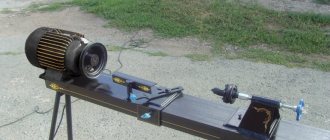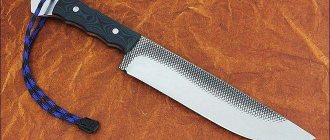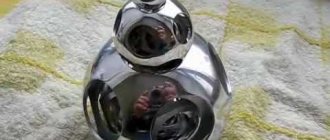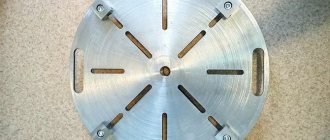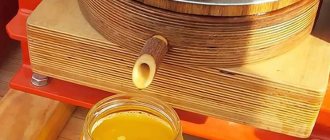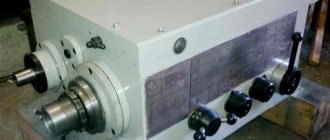In a home workshop, it often turns out that in addition to the existing tool, the smallest thing is missing - a lathe. And it’s not that wood crafts require perfectly cylindrical or spherical parts, it’s just that sometimes you want to do something that has been planned for a long time. So the thought arises, what if you make a wood lathe with your own hands, such a small machine that will take up little space and make it convenient to work with.
The device of a wood lathe
Sooner or later, almost every craftsman begins to get sick of the idea of assembling his own wood turner. Some come to this on their own, after much calculation and thought, while others remember their childhood, and the school workshop there also had woodworking machines. And it’s not difficult to assemble a woodworking machine in the image and likeness of a school one. After all, you can certainly find material in the form of pipe sections in the garage.
The first step is to remember all the main parts of the design of that same school wood lathe. There seem to be few parts here, but each of them plays a specific role, without which everything turns into a pile of scrap metal.
The basis of any machine is the bed. This is a massive base on which all other equipment is mounted. The bed must be as strong and rigid as possible; during operation it must withstand heavy loads not only in the form of a massive workpiece, but also in the form of vibration and the action of multidirectional forces when processing a wooden workpiece.
The headstock of a lathe is a device in which the drive shaft is mounted. On one side of the shaft, a workpiece clamping device is installed - a self-centering lathe chuck, a faceplate or a device onto which a wooden workpiece is screwed or hammered. On the other side of the turning shaft, a drive gear is attached, a pulley with one or more grooves for a belt drive. The turning shaft must provide rotational motion at a speed of up to 3000 revolutions; this is enough for domestic needs. Therefore, the turning shaft is usually mounted on bearings or bushings. The shaft axis is the main axis of the lathe, and the higher the shaft is above the bed, the larger the diameter of the workpiece can be machined. The processing of parts on the machine is carried out using hand cutters, and given the speed of rotation of the shaft, careless touching the pulley or belts can cause injury, so the front assembly must be covered with a protective screen or casing. Rigid fastening of the protection to the headstock is a prerequisite for safe operation.
The tailstock is installed on the opposite side. This is a rigid stop, with a cone-center, which is located exactly along the axis of the turning shaft. The center can move along the axis to secure the workpiece. To fix the position of the center, it is necessary to provide a mechanism for its fixation.
When working on a lathe, hand tools are used. In order not to keep them suspended, a support is installed between the front and rear headstock - a stop for the incisors.
To rotate the working shaft, a drive is installed; it can be an electric motor with direct or belt drive, or it can be driven by muscle power. By the way, the first wood lathes were manually driven - like a bow saw, but later they were replaced by a foot drive.
General design and structure of a homemade unit
When designing a homemade lathe for turning, you can consider two design options: with an electric drive and without an electric motor. Despite the antiquity of the method of processing wood using human muscles, this option has the right to exist in conditions where it is necessary to process wood, but there is no possibility of using electricity.
The main structural elements of a lathe are listed below.
bed
The bed is the frame of the entire mechanism. The safety of the craftsman and the quality of the future product depend on the reliability of the frame.
Electric drive
Drive: motor rotor or pedal for foot drive.
Headstock
The headstock is a chuck for clamping the product and its subsequent rotation. Rotation from the engine is transmitted to it through a gear transmission, pulleys or a belt. At the end of the headstock there is a spindle with a faceplate for fixing the product.
Tailstock
The tailstock is needed for additional fixation of the workpiece, which will help improve the accuracy of the rotation axis and avoid unnecessary vibrations. It is a freely rotating blade that can be moved along the axis of rotation of the product to adjust the distance between the headstocks.
Podruchnik
A tool rest is necessary to support the chisel while processing wood. Without a stand for a hand tool, it is impossible to maintain high accuracy of the blade tip hitting the sketch lines and it is extremely difficult to regulate the pressing force of the cutter.
Selecting a transfer method
In most homemade wood lathes, the working drive is provided by the two most popular methods - direct transmission or through belts. Both schemes are excellent for small-sized lathes with primitive devices for clamping a wooden workpiece in the form of a trident and a cone.
Direct transmission
This is a simple and effective way to drive a turning shaft. The actual working shaft here is the rotor shaft of the electric motor. The engine itself is attached to the frame or raised above the support. A clamping device is installed on the axle - a lathe chuck, a faceplate or a regular trident. This is, in principle, the whole scheme of direct drive of a lathe. The advantage of this scheme is that there is no need to look for a special turning shaft, grind out supports for it and center it. In the motor housing, the shaft is already mounted on bearings, and the engine itself has standard mounting units. The disadvantage of this scheme is that it is necessary to protect the windings from dust and shavings that will form during wood processing, and also, if you clamp the workpiece too tightly, there is a risk of the motor jamming and failure.
In addition, direct transmission does not allow adjustment of the speed. If the engine produces 1425 rpm, then the workpiece will also rotate, alas, this is clearly not enough for turning hardwood.
Belting
The design of the headstock using a belt drive significantly expands the capabilities of the lathe. Even if a pulley of the same diameter is used, this makes it possible to increase the shaft rotation speed and protect the electric motor from heavy loads; in this case, it is definitely not in danger of jamming.
If a multi-lane pulley is mounted on the working shaft, and the engine is mounted on a movable slide, then it becomes possible to regulate the speed of rotation of the shaft by moving the belt from a smaller diameter to a larger one. This is the best option; it makes it possible to process wood of a wide variety of species.
Safety instructions for use
In order for a wood lathe to serve for a long time, performing its assigned tasks efficiently, it is important to follow safety precautions when using it.
Rules and recommendations for using a wood lathe:
- The air temperature in the workshop should be between 1 and 35 degrees Celsius. If it is brought from a cold place to a warm room, it is important to allow it to warm up for 8 hours.
- You can work when the indoor humidity is no higher than 80%.
- It is important to systematically change the oil in the box when using the unit frequently. It is also important to regularly inspect the engine and remove accumulated dirt.
- After completing the work, it is important to remove all debris from its surface: chips and dust.
- Work only with tight-fitting safety glasses and protective clothing.
- It is important to remove all third-party objects that may interfere with working on the lathe.
- It is important to locate the control and switch handle outside of hazardous areas.
- Before turning on the device, it is important to carefully check the reliability of all fasteners and the degree of fixation of the part.
If you do not follow these rules, you can get serious injuries to your hands and eyes. And the machine itself will fail. Therefore, it is important not to violate safety rules when working with wood on a lathe.
Motor selection
The electric motor is selected depending on the power and size of the workpiece being processed. To work with workpieces longer than 50 cm and with a diameter greater than 10, it is recommended to choose a motor with a power of 300-400 watts. For small portable wood saws, a power rating of 80-180 watts is recommended. For mini versions used by modellers, motors with a power of 40-60 watts are also suitable.
Important parameters are also the number of revolutions and the type of voltage for operating the motor. In a home workshop, it is better to have an asynchronous motor operating from a 220-volt household network, but for large lathes for serious tasks, it is better to opt for powerful three-phase motors connected to an industrial network. For direct transmission, high-speed motors are usually used. And for a belt drive it is better to install a motor with a standard 1420 rpm.
Options for mini-lathe models
When purchasing a wood lathe for home use, it is recommended to choose imported models. They are of better quality compared to domestic models.
Imported ones have high power. When choosing, you should pay attention to price, quality, functionality. A good choice is when the ratio of the listed parameters is optimal.
HolzStar DB450
HolzStar DB450 is made in China. Costs approximately 12,000 rubles. This mini-machine is equipped with a cast iron frame with minimal vibration. In this case, small parts will be processed with maximum precision.
The advantages of this model are that the machine has a high spindle rotation speed. The indicator can be adjusted: 500 – 3150 rpm. The machine operates with a power of 370 W. Weight 38 kg.
Proma DSO-1000
The most affordable and high-quality among Czech woodworking machines is the Proma DSO-1000 model. Such a machine costs approximately 6,500 rubles. Has a power of 400 W. You can adjust the spindle speed in the range of 850 – 2500 rpm.
Weighs about 35 kg, has compact dimensions.
JED JWL-1220
The Chinese-made JED JWL-1220 mini woodworking machine is more expensive than the models described above. On average the price is 18,500 rubles. But, such a unit has a power of 750 W.
The frame is made of gray cast iron. Other elements of the device are made from the same material. This material eliminates vibration when working with wooden parts. The engine is equipped with 6 speeds and 2 modes.
In the first mode, rotation speed: 400 – 3300 rpm. In the second mode, you can smoothly switch to speeds from 500 to 3900 rpm.
The machine is secured with a quick-release lever and stands on stable rubber feet. The tool comes with a 710 mm long frame. The weight of the equipment is approximately 45 kg.
Corvette 71
The lathe has a power of 370 W, a maximum spindle speed of 3150 rpm. Can operate at five different speeds that switch smoothly.
The Corvette 71 device is used for sharpening, grinding, and polishing wooden workpieces. Thanks to the belt drive, it is protected from overloads and operates with minimal noise.
For the manufacture of products with large diameters, a faceplate is additionally used.
Materials and components
Metal is usually used to construct machines, but as practice shows, you can assemble a small lathe from improvised means, for example, pieces of plywood, wooden blocks and metal plates.
The simplest and most successful material for work is plywood; it is a strong and lightweight material that can withstand heavy loads. It’s not for nothing that plywood is used to build airplane fuselages, and if it can withstand overloads there, then it can withstand the overload as the main material for a lathe.
Connections can be made using furniture bolts, confirmat, self-tapping screws. Strengthening the structure can be done using furniture steel plates.
Manufacturing principle
It is recommended to make a wood lathe using ready-made components and parts, minimizing the manufacture of parts yourself.
At the initial stage, it is recommended to make a drawing indicating all dimensions. If possible, it is recommended to make a model out of cardboard; it will show all the subtle parts of the project. This is cheaper than correcting errors during assembly from expensive materials.
The second stage is cutting the material. When working with plywood, you will need a jigsaw or circular saw. First, the machine bed is cut out, glued and bolted together. The second stage is the design of the drive and headstock. Next is work on the tailstock and tool rest.
At the final stage, additional devices are manufactured - a copier, a milling device, and a grinding table. As practice shows, you can make a miniature lathe for modeling from plywood 18-24 mm thick in 3-4 days.
Installing the headstock and tailstock
The headstock of a lathe can be made in different design solutions. For its manufacture, you can use either ready-made units with bearings and an axle, or home-made ones.
In the first case, you can fit a hub with an axle from the front wheel of a bicycle under the turning shaft; in the second, you can simply buy two sealed bearings with an internal diameter of 10 mm, a bolt 10 mm thick, and several washers and nuts.
The supports for the headstock assembly are cut out of plywood. Holes for bearings are drilled in them. And then, bearings with a turning shaft are fixed in the holes and secured with clamping bolts. After this, the headstock of the lathe is firmly attached to the bed.
The tailstock assembly is made according to the template of the front headstock supports. A correctly made tailstock of a lathe with your own hands will be when the center of the lathe chuck and the cone center coincide. The easiest way to do this is by holding a regular pencil in the chuck and bringing the tailstock closer to it, marking the center point. After this, you can drill a hole and insert a bolt with a nut and locknut and a center sharpened to a cone.
Podruchnik
A tool rest for a wood lathe is needed as a stop on which the cutter will rest during operation. It is optimal to make the tool rest adjustable in height and so that it can move and be fixed anywhere on the frame between the headstocks. The material can be different - metal or even plywood, the main thing is that its edge on which the cutter will rest is rigid, so it is recommended to reinforce it with a metal plate. It is recommended to make the tool rest of a wood lathe adjustable - this will allow you to expand the number of operations on the machine and process parts not only along, but also across the axis of the machine.
Specifications
Since the device is designed for light turning work, its characteristics are suitable for use in domestic conditions:
- total weight of the unit - 100 kg;
- machine dimensions: 1250 by 575 by 550 mm;
- required power supply - 380V;
- power consumption of the electrical network - 0.4 kW;
- two shaft rotation speeds;
- spindle speed range - 1000–2150 rpm;
- length of wooden blank - 500 mm (max);
- thickness of the wooden blank - 190 mm (max).
The specified characteristics are sufficient for the initial training of carpenters in vocational schools, as well as for middle school students.
Important!
There is also a junior version of the STD-120 machine. Unlike the STD-120m model, it does not have a protective casing or illumination of the working area. The electrical control circuit has also been improved, and the overall level of noise and vibration has been reduced.
Purpose and recommendations for use
The lathe can be used for light wood turning work:
- internal turning and drilling of parts;
- trimming or trimming;
- turning cylindrical figures;
- processing flat surfaces on the faceplate.
The STD-120m is quite unpretentious in operation. However, to reduce the risk of injury, as well as the correct operation of the unit, it is worth following the operating requirements:
- The lathe is installed on a flat and level surface at a height of 500-600 mm from the floor. This could be a workbench or desktop.
- The safety screen on the machine must be lowered during operation. If the machine does not have a chip collection unit, it is necessary to lower the canvas skirt.
- Machine speeds are switched only after the spindle has completely stopped.
- Under no circumstances should you try to move the machine or adjust the workpiece while the motor is running.
- It is strictly prohibited to remove chips, adjust or measure the workpiece, as well as lubricate the device components while the machine is operating! The above actions can only be done after the spindle has completely stopped.
Important!
Install the machine on a flat floor surface, without distortions. To reduce risks and unforeseen situations, place a rubber backing or a sheet of plywood between the legs of the table or workbench and the floor.
It is also worth following the rules of machine maintenance to increase its service life:
- It is necessary to regularly clear chips from the work area. Also, after finishing work, you need to clean the protective screen from fine dust and sawdust.
- After finishing the work, put all the tools in the storage box. Apply neutral lubricant to unpainted areas. For example, on a guide frame.
- Check the condition of the lubrication on all components at least once a year or after 500 hours of operation.
- Upon completion of work, unplug the power cord from the outlet and loosen the tension on the V-belt.
Advantages and disadvantages
The widespread use of this machine in educational institutions is due to several positive factors:
- Low cost and long service life.
- Increased level of workplace protection.
- Comfortable work, workpiece illumination.
- A basic set of functions and tools for teaching students.
These characteristics make this model one of the most popular for training. But it also has its downsides:
- Availability of a three-phase power source for operating a 380V motor.
- You need to make a special power supply.
- Small size of the workpiece in length. It’s impossible to carve a good handle for a shovel.
- There are only two operating speeds.
The machine is capable of processing small parts made of softwood with a moisture content of no more than 20–25%.
Equipment
For a novice carpenter, the device is equipped with a full set of tools (Maisels, Reiers). The device itself consists of an electric motor, a control unit, a frame, as well as other holding and protective mechanisms. Let's look at the most important of these nodes in more detail.
Front headstock of the unit
The front headstock of the machine is used to secure and hold the part while the engine is running. It is a shaped body cast from cast iron, in which two holes for radial spherical bearings are bored coaxially.
Rear element
The back element or tailstock serves as a support for securing long workpieces, drill chucks, drills themselves, as well as other woodworking tools.
The tailstock consists of a body with a built-in quill that slides along the bed to adjust the length. The required length is fixed using a special bolt that holds the rear element in the desired position.
Main and removable devices
On the STD-120m you can install removable devices to perform various tasks:
- chuck for securing short workpieces at the end;
- center-fork, for installing and processing long parts in the center;
- faceplate.
To secure the workpiece to the outer surface, use the following devices:
- Cup cartridge. It consists of a cylindrical cavity on one side, and a shank for mounting a spindle on the other side.
- Vise chuck. Needed for processing workpieces in the shape of a quadrangle. To work, the workpiece is clamped in a chuck vice and pressed with a screw.
Both types of chucks can have screw threads instead of conical shanks for installation on the outside of the spindle.
Electrical equipment and technical parameters
The STD-120m lathe is equipped with a three-phase asynchronous motor operating on 380V alternating current. The maximum electricity consumption by the motor is 0.4 kW.
The device is controlled by a button block, on which there is a speed switch button, as well as a button to turn off the device.
Inside the control box there is a 380/24 V lighting transformer.
Important!
Do not attempt to repair or disassemble the asynchronous motor of the device yourself. To repair this unit, call a trusted electrical technician.
Kinematic diagram
Electrical diagram
General form
Selection rules before purchasing and care recommendations
Often the STD-120m machine is purchased second-hand or in a restored condition. When choosing such a device, you should pay attention to the following points:
- Condition of lubrication of components and assemblies.
- Engine operation. It should not smoke, spark or emit any strong burning odors.
- Condition of threaded connections.
These are the main problem areas that can make themselves felt at the time of purchasing the machine.
To increase the service life of the device, follow the care recommendations:
- lubricate all moving parts in a timely manner;
- clean and tidy up the work area after completing work;
- work with workpieces of acceptable size;
- Do general preventive maintenance of all nodes every two years.
The tips listed above will keep your machine in good condition for many years.
What other types of machines can be made
Even the simplest homemade wood lathes can be turned into multifunctional devices by equipping them with additional equipment. In addition, using ready-made components and parts from other equipment, you can assemble an excellent model for home creativity.
With a copier
This device will make it possible to put into production the production of similar parts. With a copier, the easiest way to turn out a chess set, cutlery handles and other items. The essence of this device is to fix a template with the profile of a future plywood blank or a finished wood part on a tool rest. To work in this case, you will need to upgrade the hand cutter by installing a limiter on it. When processing wood, the cutter processes the part, and having reached the required diameter, it rests against the edge of the template, and then, moving along the relief, it creates the desired profile on the part itself.
Mini
A mini wood lathe is needed primarily to gain initial woodworking skills. The tabletop machine is also useful for creating crafts, such as checkers or chess, and for professional use - for modelers creating architectural models or exhibition dioramas. This model is usually small in size, because most parts are rarely longer than 10 centimeters.
From an electric drill
This type of tool is simply created to be used in the construction of lathes for woodworking. Essentially, this is a ready-made headstock - there is a motor, there is a clamping chuck, there is an electric drill speed control. All that remains is to clamp the body in a clamp and install the tailstock opposite. Of course, it’s not worth working on it for hours, but for small parts this is what you need.

